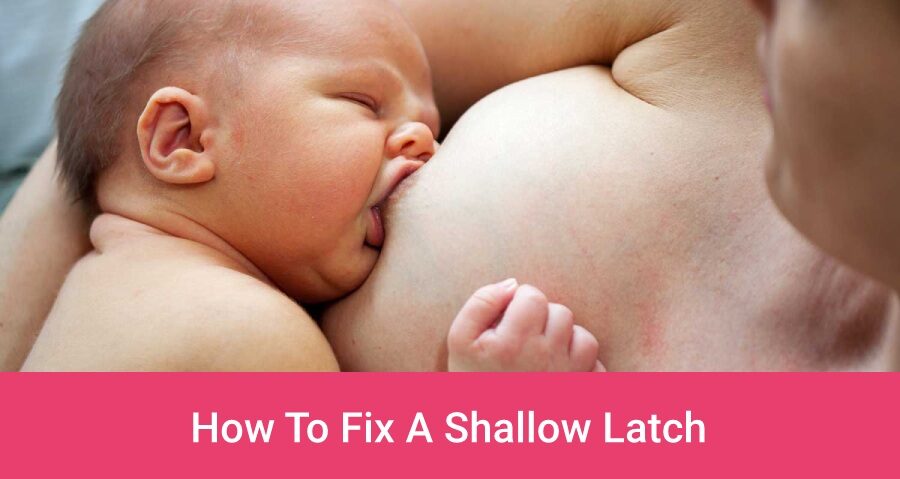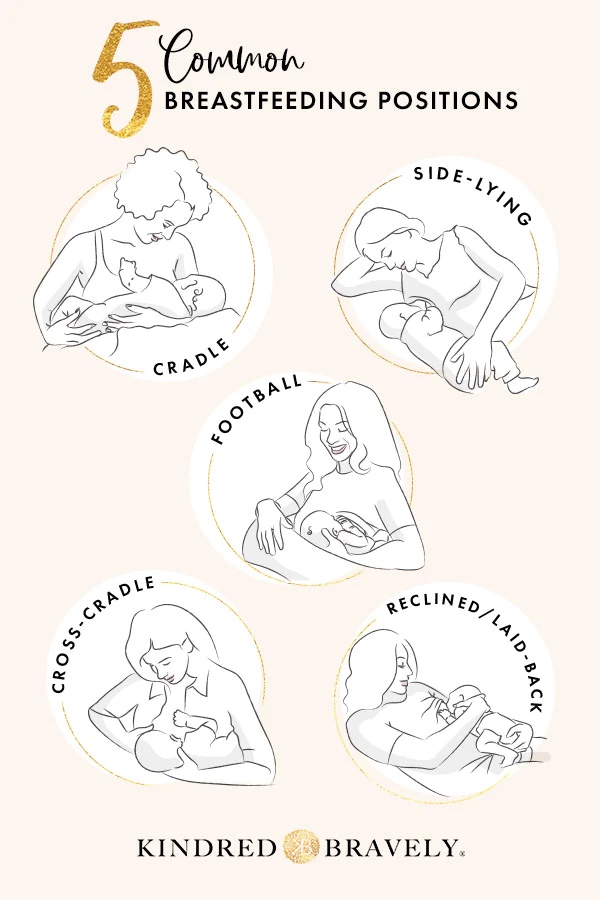Breastfeeding can be an incredibly rewarding experience for both mothers and babies. However, it’s no secret that breastfeeding can come with its own set of challenges. From engorgement to low milk supply, there are many obstacles that mothers may face on their breastfeeding journey. One of the most significant challenges can be dealing with a shallow latch.

Medically reviewed by Macy Tollefson – doula, breastfeeding specialist & prenatal yoga teacher
Breastfeeding is often touted as the most natural thing in the world, and mothers may feel like they’re failing if they can’t get it right. You may feel stressed, anxious, and worried that you’re not doing it correctly or that your baby isn’t getting enough nourishment. It can be incredibly frustrating, overwhelming, and even painful.
It’s important to note that every mother and baby’s breastfeeding journey is unique, and there’s no shame in experiencing challenges along the way.
I understand how you feel, and I’m here to tell you that you’re not alone! Many moms go through this experience, and it’s okay to feel the way you do. However, it’s crucial to address the issue of shallow latch breastfeeding because without fixing it, the breastfeeding journey may be harder, more painful, and your baby may not be getting enough food.
Let’s chat about why you may be struggling with an uncomfortable or shallow latch and explore some practical solutions to help you overcome this common challenge.
This article is not a substitute for medical advice or consultation.
What Is A Shallow Latch?
A shallow breastfeeding latch is when a baby doesn’t take enough of the breast into their mouth during breastfeeding. Instead of latching onto the entire nipple and surrounding areola, the baby only latches onto the nipple, causing discomfort and pain for the mother1.
A bad latch can make it difficult for the baby to get enough milk, and it can also cause your nipple to become sore, cracked, or even bleed. It’s important to address a shallow latch as soon as possible to avoid further damage and to ensure that the baby is getting enough milk!

How Do You Know Your Baby Has Shallow Latch?
There are several signs that may indicate that your baby has a shallow breastfeeding latch. Some telltale signs include:
- Painful breastfeeding: If breastfeeding is painful, especially during the initial latch, it may be a sign that your baby is not latching properly. The most common cause of nipple pain and bleeding is a shallow latch.
- Lip-sucking: If you notice your baby sucking on just your nipple or tugging on your breast with their lips, it may be a sign of a shallow latch.
- Ineffective feeding: If your baby is not gaining weight, is fussy or irritable after feeding, or is not having enough wet or dirty diapers, it could be a sign that they are not getting enough to drink due to a shallow latch.
- Clicking or smacking sounds: If you hear clicking or smacking sounds during breastfeeding, it may be a sign that your baby is not latched on properly.
- Nipple damage: If you have cracked, bleeding, or sore nipples, it is most likely a sign of a shallow latch. A proper latch will not damage your nipples or misshape them!
What Is The Cause Of Shallow Latch?
There are many different things that could cause your baby’s shallow latch, including:
Tongue Tie
A tongue tie is a condition where the tissue connecting the tongue to the floor of the mouth is too tight, which can restrict the baby’s ability to latch on properly2. When the thin piece of tissue that connects the underside of the tongue to the floor of the infant’s mouth is too short, it makes it difficult for the tongue to move freely.
A tongue or lip tie can be treated through a short procedure called a frenotomy, which involves snipping the tissue to release the tongue. It’s essential to work with a healthcare provider or lactation consultant to diagnose and treat tongue ties to ensure that breastfeeding is successful and comfortable for both the mother and the baby.
Breast Shape & Size
Breast shape can impact the ease of latching and finding a comfortable breastfeeding position for both the mother and baby. For example, women with larger or lower breasts may need to use a football hold or other position that supports the breast to help the baby latch on.
Nipple size and shape can also affect breastfeeding, with some women experiencing issues such as inverted or flat nipples that make it difficult for the baby to latch on properly. However, these issues can often be addressed with the help of a lactation consultant or other breastfeeding professional.
Breastfeeding Positions
An incorrect breastfeeding position, such as holding the baby too far away from the breast, can cause a improper latch. Bring your baby up to your breast instead of hunching over the reach them, and make sure you are both comfortable and well supported.
Experiment with different positions until you find the one that works best for you and offers a comfortable latch! I would also recommend breastfeeding skin to skin as much as possible, which can help trigger baby’s breastfeeding instincts.
Remember, breastfeeding position can “look” good or proper, but if it is uncomfortable or causing you pain, it is not a good latch3!

Breast Engorgement
Breast engorgement, which is the swelling and inflammation of the breast tissue due to increased blood and milk supply, can have a significant impact on a breastfeeding latch. Engorgement can cause the breast to become larger and more firm, which can make it difficult for the baby to latch on correctly. The nipple can also become flattened or elongated, which makes it harder for the baby to get a good grip on the nipple.
Engorgement can also cause a fast and forceful milk flow, which can be overwhelming for some babies. The baby may struggle to keep up with the flow of milk, causing them to pull away from the breast or choke and cough.
Lack Of Experience
Breastfeeding is a learned skill, and both the mother and newborns need to work together to establish a good breastfeeding routine! For babies breastfeeding is a completely new experience, and they need time to learn how to latch on and suck effectively.
Premature babies in particular may have difficulty latching on and nursing simply because their sucking and swallowing reflexes may not be fully developed. Comfort feedings in those early weeks can help them practice, and may help them learn to latch properly.
Nipple Confusion
Giving baby a bottle or pacifier before they have mastered breastfeeding can cause nipple confusion, and lead to a shallow latch. The reason for this is that they don’t have to work as hard to get milk out of a bottle, so they don’t understand that at the breast, they need more breast tissue in their mouth, and not only the nipple (like on a bottle)4.
This problem may also occur if you’re starting breastfeeding late and your baby has been only bottle-fed so far.
How Can I Get My Baby To Have A Deeper Latch?
Getting a deep latch is essential for both you and your baby to breastfeed comfortably and ensure that your baby gets enough to eat. Here are some tips to help your baby achieve a deeper latch:
1. Find A Comfortable Position
Your comfort is key. Choose a comfortable breastfeeding position that allows you to relax and support your baby well, such as the cradle hold, cross cradle hold, football hold, or side-lying position5.
A “laidback” breastfeeding position (where you are reclining back and your baby’s body is on top of you, tummy to tummy) can be particularly useful for babies who have a weak suck or who have difficulty latching deeply.
2. Support Your Baby’s Head And Neck
Use your hand to support your baby’s head and neck, making sure that their chin is touching your breast. Many babies DO NOT like when you hold the back of their head and pressure them to your breast (and will often fight against it), so be cautious of where you are placing that supporting hand.
3. Bring Your Baby To The Breast
Bring your baby to your breast gently, aiming the nipple towards the roof of their mouth. A good way to remember this directioning is “nipple to nose” – aim your baby’s nose toward your nipple.
4. Wait For A Wide Open Mouth
Wait for your baby to open their mouth wide before bringing them onto your breast. This is crucial to get a deep latch, as it will help your nipple go to the back of the baby’s mouth, toward the soft palate.
5. Use Your Nipple To Tickle Their Lips
Use your nipple to tickle your baby’s lips, encouraging them to open their mouth wider. Stroking baby’s cheeks can also trigger them to open their mouth.
6. Aim For A Deep Latch
Once baby opens their mouth, make sure they take in as much breast tissue as possible – not just the nipple. The baby’s lips should be flanged outwards, forming a seal around the breast. Baby’s chin should be pressed on your breast, with the entire areola in their mouth.
7. Listen For Baby Swallowing
Listen for a rhythmic, gulping sound, which indicates that your baby is effectively swallowing milk.
| Remember, it may take some practice to achieve a deep latch, and it’s essential to be patient and persistent. Seeking help from a lactation consultant or other breastfeeding professional can also be beneficial in improving your baby’s latch and making breastfeeding a more comfortable and rewarding experience for both you and your baby. You don’t need to struggle to breastfeed on your own! |
Shallow Breastfeeding Latch – FAQ
Here are some answers to common questions about shallow latching. For more breastfeeding tips, check out my article with breastfeeding hacks for new mamas.
Will A Shallow Latch Correct Itself?
Without intervention, a shallow latch can lead to many problems, such as nipple damage, clogged ducts and mastitis. It can also cause your baby to not get enough milk, which will leave them hungry and can lead to poor weight gain or dehydration.
It’s best to seek help from a lactation consultant or other breastfeeding professional if you’re experiencing pain or other issues related to a shallow latch.
Can Babies Still Get Milk With A Shallow Latch?
Yes, babies can still get milk from a shallow breastfeeding latch, but it may not be as efficient or effective as a deeper latch.
When a baby has a shallow latch, they may only be able to access the milk in the front of the breast, which is high in lactose and low in fat. This can cause the baby to become full quickly but may not provide them with the calories and nutrients they need for proper growth and development.
Why Is A Good Latch So Important?
A good breastfeeding latch is crucial because it will help with efficient milk transfer to empty the breasts (avoiding clogged ducts, mastitis, and other complications), ensure your baby is getting enough to eat, and save you from pain or nipple damage. It is essential to fix a shallow latch to avoid other breastfeeding issues!

What Does A Good Latch Feel Like?
A good latch should feel comfortable and pain-free for the mother, with no pinching, tugging, or discomfort. It may feel sensitive in the beginning (especially if it is your first time) but a good latch will NOT be painful.
How To Properly Latch A Newborn Baby
To properly latch a newborn baby, find a comfortable nursing position (try skin to skin!) and make sure their mouth is wide open with their lips flanged out. Bring them to the breast with their chin touching the breast and their nose close to but not pressed against it, ensuring that they take in a significant portion of the areola and nipple deep in their mouth.
If you are struggling to latch your baby, a lactation consultant can help you fix it! There’s no need to stress on your own.
Article By Macy Tollefson
Macy Tollefson is a full spectrum doula, breastfeeding specialist and prenatal yoga teacher. She is passionate about guiding the modern mama on her journey through the beautiful (and wild) transformation of pregnancy, birth and postpartum. Macy envisions a world where every mother has access to the resources she needs, and follows her intuition to make the best decisions about what is right for her and her baby.
The purpose of this article is informative. It’s not a substitute for professional medical advice or medical care. Remember: safety first! Consult your doctor/pediatrician in case of any doubts. The author of this article does not accept any responsibility for any liability, loss or risk, personal or otherwise, incurred as a consequence, directly or indirectly, from any information or advice contained here.
Resources:
https://www.lllc.ca/
https://www.healthline.com/
https://milkology.org/
https://llli.org/


